Text and photos by Mary L. Peachin, Bill Kimball, David Lovitt, Cameron Azad, and Alan Lawlor
Vol. 11 No. 2
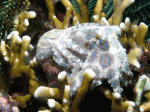 Diving in murky water just didn’t make sense. Surely, this wouldn’t appeal to wall cruisin’ big animal lovers. Inexplicably, experts flock to Lembeh Strait, renown for its silt-like black lava sand muck diving. Why descend 20-30 feet into water filled with stinging hydroids, and God knows what else, to scan a bottom covered with junk and scattered trash, a dozen varieties of empty bottles of beer, old fish nets and bamboo traps, discarded rice bags, and, perhaps, a coral bommie here and there?
Diving in murky water just didn’t make sense. Surely, this wouldn’t appeal to wall cruisin’ big animal lovers. Inexplicably, experts flock to Lembeh Strait, renown for its silt-like black lava sand muck diving. Why descend 20-30 feet into water filled with stinging hydroids, and God knows what else, to scan a bottom covered with junk and scattered trash, a dozen varieties of empty bottles of beer, old fish nets and bamboo traps, discarded rice bags, and, perhaps, a coral bommie here and there?
Well, muck diving is like exploring a landfill filled with the world’s most incredible critters and Lembeh Strait may be the frog fish and nudibranch capital of the underwater world. It took just one dive to realize that this is as fascinating as diving can be.
Kungkungan Bay Resort (KBR) is located near Bitung City in Indonesia’s North Sulawesi. Isolated and literally at the end of the road, 17 bungalows bordered by tropical rainforest and surrounding coconut plantations, overlook the mile-wide Strait. Overlook a few mosquitoes and other bugs, and it’s utopic.
The most jaded diver, one who has “been there and seen that underwater will agree that Lembeh Strait will just plain “knocked your dive booties off.”
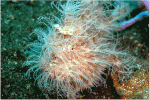 At Nudi Retreat, flamboyant pygmy cuttlefish camouflaged themselves in gorgonians. A newborn, recognizable only by its shape and color changes, clung to a soft coral. Talk about underwater sensory overload! And, there was much, much more.
At Nudi Retreat, flamboyant pygmy cuttlefish camouflaged themselves in gorgonians. A newborn, recognizable only by its shape and color changes, clung to a soft coral. Talk about underwater sensory overload! And, there was much, much more.
On a single dive, we saw a longfin waspfish, spiny devilfish, leaf scorpionfish, an ugly sand-buried reticulated stargazer, plus a variety of living shells.
About a third of our group of 18, the infamous, worldly, fearless hyper-diving “Chickens” has become international in scope. Inclusively growing from several Arizona “desert rats” led by Commander Pollo, the group now includes divers from the UK, Germany, Sweden, a German ex-pat from Shanghai with a friend from Jakarta. Yup, for this trip, the “Chickens” spared their squawking rubber mascot from its usual inclusion in a shark bait ball to go on “the ultimate critter hunt”.
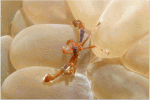 Several nights, the Chickens took advantage of nighttime explorations to see fully exposed flat-headed stargazers, the frizzy “bad hair day” bright orange hirsute hairy frogfish, and other nocturnal critters. Another night it was a crabfest: an orange and purple decorator crab carrying a live urchin. They even saw a red octopus.
Several nights, the Chickens took advantage of nighttime explorations to see fully exposed flat-headed stargazers, the frizzy “bad hair day” bright orange hirsute hairy frogfish, and other nocturnal critters. Another night it was a crabfest: an orange and purple decorator crab carrying a live urchin. They even saw a red octopus.
Yellow-headed, big snouted, creamy brown-finned, and a small pink eel were not like your ordinary moray. Mouthing their jaws in unison, they frequently shared crevices. Other uncommon species included the minor, barbed fin, white-eyed, snowflake, and the blacksaddle snake eel that poked his head out of the sand.
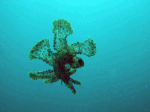 The “mine field” of creatures around the sites at Teluk Kambaku included Leopard, Heron Island, black-margined, obscure hypselodoris, turberculate mexichromis, eye-spot, and elegant nudibranchs. Larger than a tennis ball, a yellow and black Notodoras Minor looked like a ripened banana.
The “mine field” of creatures around the sites at Teluk Kambaku included Leopard, Heron Island, black-margined, obscure hypselodoris, turberculate mexichromis, eye-spot, and elegant nudibranchs. Larger than a tennis ball, a yellow and black Notodoras Minor looked like a ripened banana.
We learned a whole new underwater sign language. A curled index finger signaled a seahorse, or a curled pinky indicated a pygmy seahorse. Two-handed index finger wiggles meant a fingered dragonet. It was a “Scuba 101” fish identification for experienced divers.
 Many hues of clownfish darted in and out of different colored anemones, sometimes surrounded by schools of white-spotted, black-barred Banggai cardinalfish. The clownfish were very protective, a “Nemo” bit one diver three times during the week. Those cute little fish prefer knuckles.
Many hues of clownfish darted in and out of different colored anemones, sometimes surrounded by schools of white-spotted, black-barred Banggai cardinalfish. The clownfish were very protective, a “Nemo” bit one diver three times during the week. Those cute little fish prefer knuckles.
Frog fish have different color phases during their life. We saw yellow, white, green, orange, pink combined with brown, and black. Some of them were as small as a lime, others as big as a football. A pregnant female, her belly bulging, hung near her mate on an abandoned anchor line. Like a piece of a sculpture, a chartreuse frog fish clandestinely fished from the stem of an elephant ear-shaped leather coral. In a split second, a black frogfish, tucked in a bommie, consumed unwitting cardinal fish.
Juvenile batfish glided in and out of bommies. A brown cockatoo waspfish could easily have been mistaken for a leaf. Different sizes and colors of zebra, dwarf, spotfin, deepwater, weedy, and demon lionfish tucked under corals, rested on the sand, or drifted slowly in the gentle current.
Scorpionfish were plentiful and included the long mustached ambon with horny growths above its eyes. Marked by white algae and sponge-like calcification, the humpback was equally weird. A brilliant yellow-fringed weedy scorpionfish drifted like an autumn leaf. To everyone’s delight, the sand and rubble brought several sightings of the purple weedy Rhinopeous.
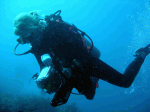 Fire urchins used two white front legs to march along the bottom like an army battalion. This was certainly not a good place to lose control of your buoyancy. Spiny devilfish, sea moths, and fingered dragonet’s were so ugly; one wondered who would prey upon them?
Fire urchins used two white front legs to march along the bottom like an army battalion. This was certainly not a good place to lose control of your buoyancy. Spiny devilfish, sea moths, and fingered dragonet’s were so ugly; one wondered who would prey upon them?
An octopus took refuge in an empty bottle. Striped zebra crabs fed on dead urchins. Two Pegasus seamoths crawled along the black sand. Banded coral shrimp scurried about openly. Golden bristle fire worms crawled through the sand, file soft-shelled clams used banded tentacles for swimming. The long spines of the Venus Comb murex were stunning.
Nudi Falls was a three minute ride from the resort. A whip coral goby skipped up and down the thin coral. Nearby we saw a white-ringed black-spotted tail comet fish, orange and red warty pygmy seahorses in sea fans, a yellow soft coral crab hiding in gorgonians, and winged and ring pipefish.
At a mucky spot named Hairball, the smallest of the sharks: a six inch black and white striped epaulet slept on the bottom. Overturning a rock at nearby Batu Merah, we found a second one: this time a three inch juvenile.
Several malibi nudibranchs floated like plastic bags. A paradise mantis shrimp wasn’t shy, while a pair of sailfish gobies ducked into holes. An orange juvenile puffer hung with a white frogfish. Whiskered eel catfish stirred up the muck as they fed in a school in the sand, rigid shrimpfish swam in vertically formation.
An option to a night dive was a dusk mandarin dive. Beautifully ornate with patterned dark-edged green and blue bands and yellow line markings on lower part of their head, they are extremely shy. As the sun set, we patiently waited in the coral rubble at Batu Angus for them to swim out of the bommie to do their elaborate dancing mating ritual. We saw about a dozen fish, but no mating.
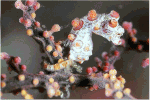 KBR’s intimacy oozes charm, service, romance and atmosphere. Lembeh is a place worth traveling through countless time zones to endure the agony of horrendous jet lag.
KBR’s intimacy oozes charm, service, romance and atmosphere. Lembeh is a place worth traveling through countless time zones to endure the agony of horrendous jet lag.
Until 1990, KBR was a coconut plantation. When America’s Supercuts heiress Kathryn Ecenbarger cruised through the strait, she found the place so beautiful, she mentioned to ship Captain Billy Matindas that the bay should be developed as a resort. He offered to help arrange for her to buy the land.
In 1991, Ecenbarger sent her son, Mark, a contractor, to build a resort. Mark was a diver, but after one look at the muck and poor visibility, he was not motivated to get wet. As time passed, he felt frustrated waiting for building materials to arrive. He descended into the Strait and began discovering critters he couldn’t identify in any book. The realization hit him that the diving in Lembeh was unique. Three years later, a simple resort became a world class dive operation, a destination attracting worldwide experts.
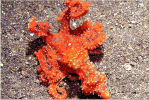 By leasing the reefs from the government, KBR has proprietary use of them and is able to keep them pristine. The “no glove” rule is mandatory. Eco Divers, who also operates a resort in Manado, manages KBR’s dive operation.
By leasing the reefs from the government, KBR has proprietary use of them and is able to keep them pristine. The “no glove” rule is mandatory. Eco Divers, who also operates a resort in Manado, manages KBR’s dive operation.
Three years ago, after one too many bouts with malaria, Miranda and Steve Coverdale, longtime dive operators, jumped at the opportunity to transfer from the Red Sea in Sudan to manage the resort.
After an early breakfast, each dive day at Kungkungan Bay Resort begins on the pier at 8 am. Steve gives notice, “if you are a minute late, you’ll miss the boat.” But, alternatively, you can always dive the “house” reef, just off the end of the pier.
There are two morning dives, a lunch buffet, afternoon dive, menu-ordered dinner, and optional night dive (for $35.00).
KBR’s wooden bungalows have views of the white sandy beaches across to Lembeh Island. Most of the thatch-roof bungalows have two suites with a shared porch, a porch with comfy wicker furniture. There is a screened living area with a mini-bar. The bedroom has two queen-size beds and is air-conditioned. The bathroom is spacious, with plenty of storage space, but dim on the lighting and nil on air conditioning. Voltage is 220 in rooms (110 and 220 in camera room), but they will lend you an adapter for your room. Reasonably priced laundry service is available. The room is pleasant and comfortable.
The main lodge and dive shop are the focal points of KBR. There is a bar, dining area, and upstairs with TV, internet, telephone, and seating to view the Strait. Behind the attractive beachfront infinity swimming pool, KBR is building a spa. Currently, a diminutive massage therapist, a woman with strong hands, runs from one appointment to the next each day between and after dives.
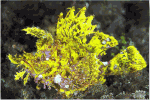 The dive facility has ceramic tubs for gear with two “holy water” tanks assigned for camera gear. The camera room is basic, but elaborate. Each diver has their own towel-covered charging station and lighted workspace.
The dive facility has ceramic tubs for gear with two “holy water” tanks assigned for camera gear. The camera room is basic, but elaborate. Each diver has their own towel-covered charging station and lighted workspace.
There is a pair of hot showers, a toilet, and two briefing thatched-roof huts lined with benches, a building filled with oxygen and rental gear. Because KBR wants divers using computers, there is no charge for the few who might need one. Nitrox, always 32+ percent, costs $75.00 for 3 days then $15.00 a tank.
It’s a giant stride distance to reach the 16- foot dive boats. Divers climb over the bow then sit on cushion seats covered by an awning. Aluminum 80 tanks are kept in holders along the gunwales. Sites are 3-20 minutes away. Uncrowded eight-paks on each boat are divided into two groups, each backrolling with a divemaster. Access into the boat is by ladder. The crew helps divers don their gear and get in and out of the water.
Someone is in the kitchen around the clock. In fact any service is available 24 hours a day. Mexican, Italian, American, and Indonesia cuisine is served. Breakfast and lunch are buffet style and when coffee was not ready, the group waited impatiently. The service “with a smile” was very accommodating, but admittedly slow. Dishes varied in quality, dessert lacking.
From the time we arrived, we never touched our gear. Our only responsibility was confirming and signing off on our nitrox percentage, always steady at 32-ish percent. The crew helped us with our gear, and passed warm towels, fruit, and water after each dive. It was a first class operation.
 Never thought I’d say this about muck diving, but KBR was one of the highlights of my underwater adventures. We saw more new, unique stuff in five days, that in our decades of diving. What didn’t we see? To mention a few, there was Saron shrimp- red polka-dotted with yellow carapace and green Halimeda Ghost Pipefish in fronds of halimeda sea grass. Lucky for them, some of the group saw the mimic octopus and orange hairy frogfish.
Never thought I’d say this about muck diving, but KBR was one of the highlights of my underwater adventures. We saw more new, unique stuff in five days, that in our decades of diving. What didn’t we see? To mention a few, there was Saron shrimp- red polka-dotted with yellow carapace and green Halimeda Ghost Pipefish in fronds of halimeda sea grass. Lucky for them, some of the group saw the mimic octopus and orange hairy frogfish.
If you go:
Singapore is the gateway to Manado. West Coast divers flew non-stop on Singapore Air from LAX. Several Midwesterners traveled on Northwest through Tokyo. I flew Cathay Pacific and broke up the journey with a night at the luxurious Intercontinental Hotel in Hong Kong and a second night at the Four Seasons in Singapore.
Getting to KBR, www.kungkungan.com, is an interesting hour and a half journey through lush countryside from Manado’s Samratulangi airport. Along a potholed, two-lane highway, women in conical hats tend rice paddies. Coconut and banana plantations line the road. Houses have rusty corrugated roofs. Noticing “rabbit ears”, it appeared as if at least one home in each village had television. Between the city of Manado and Bitung, oxen pull wagons of rocks and other heavy loads. Most locals traveled by scooter.
Roadside vendors sold bananas and pineapple, juice, and ice cream. After the long journey it seems like a long road trip, but it’s an interesting one.
